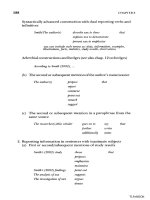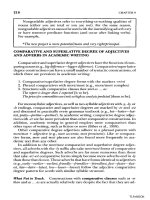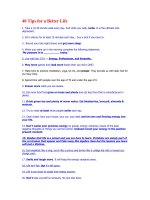Tài liệu Teaching English Spelling. A Practical Guide pdf
Bạn đang xem bản rút gọn của tài liệu. Xem và tải ngay bản đầy đủ của tài liệu tại đây (232.43 KB, 19 trang )
Teaching English Spelling
A practical guide
Ruth Shemesh
Sheila Waller
PUBLISHED BY THE PRESS SYNDICATE OF THE UNIVERSITY OF CAMBRIDGE
The Pitt Building, Trumpington Street, Cambridge, United Kingdom
CAMBRIDGE UNIVERSITY PRESS
The Edinburgh Building, Cambridge CB2 2RU, UK
40 West 20th Street, New York, NY 10011–4211, USA
477 Williamstown Road, Port Melbourne, VIC 3207, Australia
Ruiz de Alarcón 13, 28014 Madrid, Spain
Dock House, The Waterfront, Cape Town 8001, South Africa
© Cambridge University Press 2000
This book is in copyright, which normally means that no reproduction of any part may
take place without the written permission of Cambridge University Press. The copying
of certain parts of it by individual teachers for use within their classrooms, however, is
permitted without such formality. To aid identification, pages which are copiable by the
teacher without further permission are identified by a separate copyright notice:
© Cambridge University Press 2000.
First published 2000
Reprinted 2002
Printed in the United Kingdom at the University Press, Cambridge
Typeset in Sabon 10.5/12pt
A catalogue record for this book is available from the British Library
Library of Congress Cataloguing in Publication data applied for
ISBN 0 521 63971 9 paperback
Contents
Thanks vii
Introduction 1
1 Vowel sounds 9
1.1 Short vowel sounds 9
1.2 Short and long vowels – a comparison 21
2 The sound ‘k’ (/k/)24
2.1 ‘c’ or ‘k’ 24
2.2 ‘-ck’ or ‘-k’ at the end of a word 34
2.3 ‘-ic’ 42
2.4 ‘qu’ 51
2.5 ‘-x’ 59
3 Single vowel followers 69
3.1 ‘-ll’, ‘-ss’ (‘-ff’, ‘-zz’)69
3.2 ‘-dge’ 77
3.3 ‘-tch’ 82
4 The sound ‘i’ (/a/)89
4.1 ‘i-e’ 89
4.2 ‘-y’ 100
4.3 ‘-igh’ 110
5 The sound ‘a’ (/e/) 116
5.1 ‘a-e’ 116
5.2 ‘-ay’ 126
5.3 ‘ai’ 135
6 The sound ‘o’ (/əυ/) 141
6.1 ‘o-e’ 141
6.2 ‘-ow’ 153
6.3 ‘oa’ 162
v
7 The sound ‘u’ (/ju/and/u/) 170
7.1 ‘u-e’ 170
7.2 ‘-ue’ 176
7.3 ‘-ew’ 181
7.4 ‘oo’ 188
8 The sound ‘e’ (/i/) 200
8.1 ‘ee’ 200
8.2 ‘ea’ 209
8.3 ‘-y’ 217
8.4 ‘ie’ and ‘ei’ 228
9 Soft and hard sounds (/s/, // and /d/) 236
9.1 The soft ‘c’ 236
9.2 The soft and hard ‘g’ 249
10 Odds and ends 259
10.1 Silent letters 259
10.2 ‘-tion’ and ‘-sion’ 269
10.3 ‘-le’, ‘-al’ and ‘-el’ 277
Recommended resources 290
Index 291
vi
Contents
9
1 Vowel sounds
1.1 Short vowel sounds
Lesson plan
This unit deals with the students’ listening awareness of both short
and long vowel sounds. You might note that there is no universally
agreed concept of what each vowel sound should be. Although this
book uses the phonetic symbols from the International Phonetic
Alphabet, which is based on Southern British English pronunciation,
there are many other acceptable pronunciations which you could
check in a good dictionary.
Each word, when sounded out, has one or more beats. Each beat is
a syllable. In every beat (syllable) we usually hear a vowel sound. A
vowel sound occurs when the mouth is open, the air can flow freely
and the tongue is at rest. The vowels are ‘a’ ‘e’ ‘i’ ‘o’ ‘u’ and
sometimes ‘y’. One or two vowel letters may combine to make one
sound, as you can see in the following:
one-syllable words two-syllable words three-syllable words
can can - dy can - di - date
hope hope - ful un - hope - ful
weight weight - less weight - less - ness
When writing, students may rely only on their auditory memory, that
is, they write the way they remember the sound of a word. (The word
‘week’ may be written as ‘wik’, if that is what the students hear.)
Therefore, in this unit, the differences between the various short vowel
sounds are practised. Next, students are introduced to the differences
between the short and long vowel sounds. Later units will deal with
each long vowel sound individually.
1
ELICIT
: Ask students for the names of the vowels. Write them on the
board: A E I O U. Remind the students that all the other letters are
called consonants, apart from Y, which sometimes acts as a vowel
and other times as a consonant. (In less advanced bilingual classes,
this part of the lesson can be done in mother tongue.)
2
WRITE ON THE BOARD:
aeiou
cat bed big hot fun
Ask students to give other words that follow the same CVC
(consonant – vowel – consonant) pattern of letters and add them to
the table.
Students copy the table and three examples for each vowel into
their notebooks.
3
ASK:
What sound does each vowel have when it is ‘sandwiched’
between two consonants? Answer: The vowel does not say its name,
but is pronounced as a short sound: // as in cat; /e/ as in bed; // as
in sit ; /ɒ/ as in hot and // as in fun.
The vowel will be pronounced in its short form in VC words, like
at, it, up, on.
You might want to explain to more advanced classes that this
pronunciation does not apply to some one-syllable words that end
in ‘-ld’, ‘-st’, or ‘-nd’, where the vowel sound is long: /a/ as in kind,
mind, child;/əυ/ as in old, most, post.
Warm-up practice of short vowel sounds
* Beginners
In turn, students say aloud to the rest of the class one short vowel
sound, without revealing the name of the vowel being pronounced, for
example, Student A says ‘//’ as in sit. The other students must guess
which vowel is being referred to. Do this until all the vowel sounds
have been covered and students feel confident in identifying the short
vowel sounds.
* Intermediate
Write on the board:
bag beg big bog bug
You should now carefully pronounce each word out loud to the class.
Tell the class that when the next word is called out, they must identify
which word was said and write it down in their notebooks. It’s a good
idea to go over the correct answer after each word and possibly re-test
words that were problematic for the students.
10
Vowel sounds
* Advanced
The following are a number of listening exercises that use the same list
of words and are aimed at strengthening the students’ perception of
the five short vowel sounds. You could either write the list on the
board or photocopy it and hand out to each student.
© Cambridge University Press 2000
1 Dictate one word from each line. Ask the students to underline the
word they hear.
2 Another way you might like to consider is to read out all the words
from each line, but at random. Students number the words in the
order they hear them. For example, (line 5), the words are read out
in the order of chop, chip and chap. The students would write their
answer like this:
2 3 1
chip chap chop
3 Students work in pairs, taking turns reading out one word from
each line. The partner must identify the word by pointing to it on
the page.
4 Taking turns, one student dictates a word and the partner writes it
down, without looking at the list.
You might like to ask the students:
• What difficulties did you have when doing these exercises?
• What was easier for you?
• Which sound/letter did you have most difficulty with?
Listening Exercise – Short Vowel Sounds
1 bad bed
2 cop cup
3 bit bat
4mud mad
5 chip chap chop
6 drunk drink drank
7an in on
8 pet pit pat
9 hut hot hit hat
10 bug bag big beg
11
Vowel sounds









